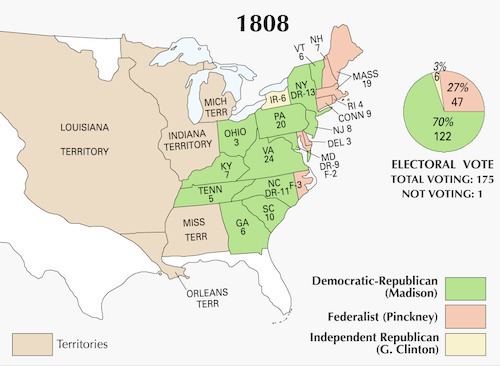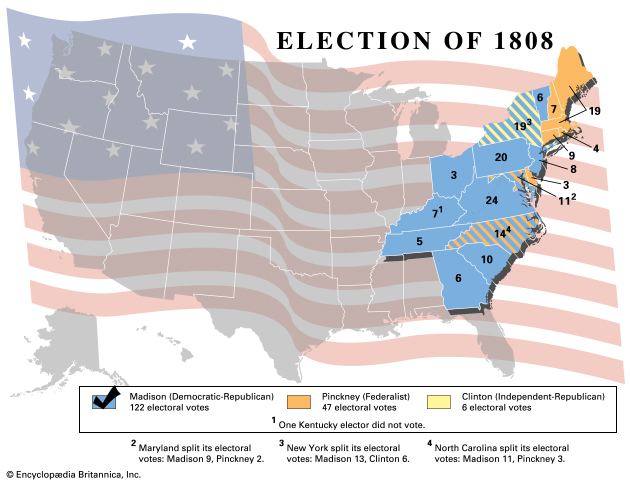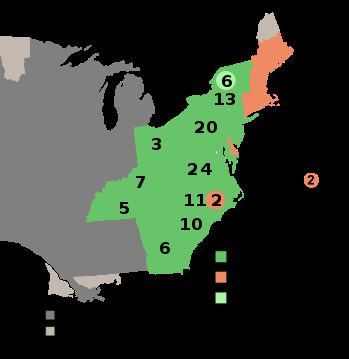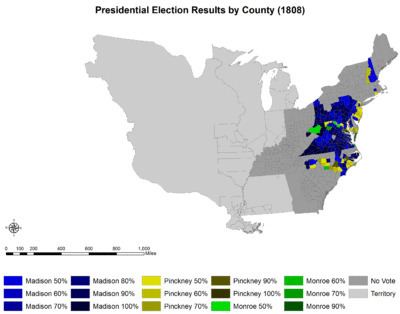November 4 – December 7, 1808 1812 → 12 5 64.7% 32.4% | 122 47 124,732 62,431 Start date 1808 | |
 | ||
Winner James Madison Other Instances United States presidenti, United States presidenti, United States presidenti, United States presidenti, United States presidenti | ||
The United States presidential election of 1808 was the sixth quadrennial presidential election, held from Friday, November 4, to Wednesday, December 7, 1808. The Democratic-Republican candidate James Madison defeated Federalist candidate Charles Cotesworth Pinckney decisively. Madison was serving as United States Secretary of State under incumbent Thomas Jefferson, and Pinckney had been the unsuccessful Federalist candidate in the election of 1804.
Contents
- Presidential candidates
- Vice Presidential candidates
- Caucus
- Federalist Party nomination
- Campaign
- Results
- References

Madison's strongest challenge came from members of his own party. Sitting Vice President George Clinton and former Ambassador James Monroe both challenged Madison for leadership of the party prior to the general election. Clinton received six electoral votes in the general election, all from New York.

This election was the first of only two instances in American history in which a new President would be selected but the incumbent Vice President would continue to serve. (The re-election of John C. Calhoun in 1828 was the other instance.)

Presidential candidates

Vice-Presidential candidates

Caucus
Nominations for the 1808 presidential election were made by congressional caucuses. With Thomas Jefferson ready to retire, supporters of Secretary of State James Madison of Virginia worked carefully to ensure that Madison would succeed Jefferson. Madison's primary competition came from former Ambassador James Monroe of Virginia and Vice President George Clinton. Monroe was supported by a group known as the tertium quids, who supported a weak central government and were dissatisfied by the Louisiana Purchase and the Compact of 1802. Clinton's support came from Northern Democratic-Republicans who disapproved of the Embargo Act (which they saw as potentially leading towards war with Great Britain) and who sought to end the Virginia Dynasty. The Congressional caucus chose Madison as its candidate for president and Clinton as its candidate for vice president.
Many supporters of Monroe and Clinton refused to accept the result of the caucus. Monroe was nominated by a group of Virginia Democratic-Republicans, and although he did not actively try to defeat Madison, he also refused to withdraw from the race. Clinton was also supported by a group of New York Democratic-Republicans for president even as he remained the party's official vice presidential candidate.
Federalist Party nomination
The Federalist caucus renominated General Charles Cotesworth Pinckney of South Carolina and former Senator Rufus King of New York.
Presidential candidates
Vice-Presidential candidates
Campaign
The election was marked by opposition to Jefferson's Embargo Act of 1807, a halt to trade with Europe that disproportionately hurt New England merchants and was perceived as favoring France over Britain. Nonetheless, Jefferson was still very popular with Americans generally and Pinckney was soundly defeated, though not as badly as in 1804. Pinckney received few electoral votes outside of New England.
Results
Pinckney retained the electoral votes of the two states that he carried in 1804 (Connecticut and Delaware), and he also picked up New Hampshire, Massachusetts, Rhode Island, and three electoral districts in North Carolina besides the two electoral districts in Maryland that he carried earlier. Except for the North Carolina districts, all of the improvement was in New England.
Monroe won a portion of the popular vote in Virginia and North Carolina, while the New York legislature split its electoral votes between Madison and Clinton.
Source (Popular Vote): U.S. President National Vote. Our Campaigns. (February 10, 2006).
Source (Popular Vote): A New Nation Votes: American Election Returns 1787-1825
Source (Electoral Vote): "Electoral College Box Scores 1789–1996". National Archives and Records Administration. Retrieved July 30, 2005.
(a) Only 10 of the 17 states chose electors by popular vote.
(b) Those states that did choose electors by popular vote had widely varying restrictions on suffrage via property requirements.
(c) One Elector from Kentucky did not vote.
